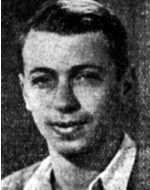Natik, Amnon-Moshe
Son of Esther and Zvi, was born on November 5, 1926, in Jerusalem. Until the age of five he grew up in Talpiot and from then on in Beit Hakerem. Where he attended elementary school and high school until the sixth grade. From his childhood he was an active member of Mahanot Ha’olim and wanted to embark on a pioneering realization. He liked nature and agricultural work from the days of his devoted care of the garden of the house, which she remembered deep in his Lev and accompanied him even when he sang in the distance. After finishing sixth grade, he studied for two years at the agricultural high school in Pardes Hannah and excelled in his diligence and devotion to work. Amnon-Moshe completed his studies in 1944 and served two years in the Palmach in Beit Ha’arava, Hefetzi and Afikim, where he was particularly active in agriculture, training and travels, and blowing up railroads and bridges during the revolt. In the summer of 1945 he was released from the Palmach for three months, and in order to get to know the Arab way of life, he spent two months in the village of Beit Mahsir near Sha’ar Hagai in the Falahim home, where he lived and worked with them. In February 1947 he studied zoology and botany at the Hebrew University of Jerusalem, Was later to be paid for in forestry in the United States. Shortly after he began studying at the beginning of 1948, he came to the service of the homeland the day after the United Nations General Assembly resolution on the partition of the land. He served in the vicinity of Jerusalem in defense of transportation and fought fiercely against the rioters (he asked his commander, however, that if he had to attack the village of Beit Mahsir, he would not share this with him because he said, “I ate bread in that village”). Amnon-Moshe was sent to Sodom, to the House of the Arava and to Kalia, participated in the destruction of the North Sea Dead Sea plant and in the retreat to Sodom where he served in the isolated Guard Corps. He participated in combat activities and in general and cultural training. Before his descent to the Dead Sea, he was in a squad commanders’ course while his comrades were sent as reinforcements to Gush Etzion and fell on the way, and thus escaped their fate, but in his letters to his sister he doubted whether such miracles should be welcomed. His letters from the Dead Sea, which excel in poetic landscapes and juicy humor, are examples of the same living humor in which he tried to “hold the soul” in his friends. In the days of his first service in Sodom, the Dead Sea once traveled to Jerusalem accompanied by a father, who led the way home to bury his son who fell in battle, and on the way tried to console him and said, “What can we do, if we do not fight, Tomorrow – perhaps selfish. ” But it is impossible to fall in battle. As a reward for daring action he received ten days off and flew home. As the plane approached the landing at Sde Dov near Tel Aviv, he was caught in an Egyptian bombardment of the city and landed on the sands of Nebi-Rubin. An Arab gang attacked the passengers of the plane and murdered Amnon and his four friends on the 18th of Tammuz 5708 (July 18, 1948). He was laid to rest in the military cemetery at Nahalat Yitzhak.
